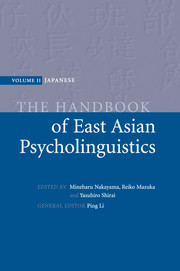Book contents
- Frontmatter
- Contents
- List of figures
- List of contributors
- In memory of Miwa Nishimura
- Preface
- Introduction
- Language acquisition
- Part II Language processing
- 26 The phonetic and phonological organization of speech in Japanese
- 27 Speech segmentation by Japanese listeners: its language-specificity and language-universality
- 28 Prosody in sentence processing
- 29 Speech errors
- 30 Effects of word properties on Japanese sentence processing
- 31 Orthographic processing
- 32 Lexical access
- 33 Incrementality in Japanese sentence processing
- 34 Processing alternative word orders in Japanese
- 35 Processing relative clauses in Japanese: coping with multiple ambiguities
- 36 Processing empty categories in Japanese
- 37 The difficulty of certain sentence constructions in comprehension
- 38 Reading and working memory
- 39 Sentence production in Japanese
- 40 The neural basis of syntactic processing in Japanese
- 41 The competition model
- 42 Connectionist models
- 43 Computational linguistics
- 44 Language and gesture as a single communicative system
- References
- Name index
- Subject index
27 - Speech segmentation by Japanese listeners: its language-specificity and language-universality
from Part II - Language processing
Published online by Cambridge University Press: 05 June 2012
- Frontmatter
- Contents
- List of figures
- List of contributors
- In memory of Miwa Nishimura
- Preface
- Introduction
- Language acquisition
- Part II Language processing
- 26 The phonetic and phonological organization of speech in Japanese
- 27 Speech segmentation by Japanese listeners: its language-specificity and language-universality
- 28 Prosody in sentence processing
- 29 Speech errors
- 30 Effects of word properties on Japanese sentence processing
- 31 Orthographic processing
- 32 Lexical access
- 33 Incrementality in Japanese sentence processing
- 34 Processing alternative word orders in Japanese
- 35 Processing relative clauses in Japanese: coping with multiple ambiguities
- 36 Processing empty categories in Japanese
- 37 The difficulty of certain sentence constructions in comprehension
- 38 Reading and working memory
- 39 Sentence production in Japanese
- 40 The neural basis of syntactic processing in Japanese
- 41 The competition model
- 42 Connectionist models
- 43 Computational linguistics
- 44 Language and gesture as a single communicative system
- References
- Name index
- Subject index
Summary
Introduction
Spoken-word recognition, or how human listeners comprehend the meaning of speech, is one of the main topics of psycholinguistics. More specifically, the study of spoken-word recognition explores how human listeners manage to retrieve the individual words which make up continuous spoken utterances. Speakers do not utter a segregated sequence of isolated words; they run words together without an intervening pause, so that utterances reach listeners as a continuous stream. Given that all human language users use speech as a primary means to communicate, and that no human listeners with normal hearing capacity fail to extract the meaning of utterances, the human speech recognition system must be very efficient at detecting words in continuous speech, i.e. at speech segmentation.
During the past thirty years or so, the study of speech segmentation has progressed remarkably. Many types of phonetic and phonological information have been reported to be segmentation cues. For example, aspiration of word initial stops in English (Lehiste, 1960; Nakatani & Dukes, 1977), duration of segments (Lehiste, 1972; Klatt, 1974, 1975), phonotactics (McQueen, 1998), and silence (Norris et al., 1997) all act as segmentation cues. Although each of these individual cues certainly provides us with salient segmentation information, they will not always be present, so this is not the whole picture of the segmentation process. The ultimate goal of psycholinguistics is to reveal both universal and language-specific aspects of language processing, and the study of speech segmentation is no exception.
- Type
- Chapter
- Information
- The Handbook of East Asian Psycholinguistics , pp. 201 - 207Publisher: Cambridge University PressPrint publication year: 2006
- 2
- Cited by



